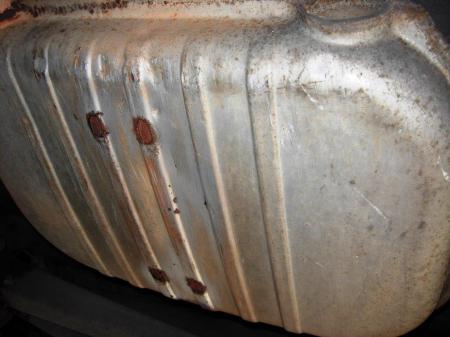Noticed a different sound from the car when standing next to it while idling. Sort of a sharp gurgling sound that seemed to come from under the left rear passenger seat.
Crawled under there with the engine running and could feel exhaust pressure coming from several holes in the muffler. Oh boy, time to repair or replace.
Exhaust leaks are potentially dangerous if deadly carbon monoxide (CO) creeps into the cabin. If the floor is solid and tight, not much exhaust can get in but cabins aren’t always exhaust-tight. For this reason automotive inspections don’t allow exhaust leaks ahead of the tailpipe. Better play it safe with this and fix the leak, even if we have several months left on the state inspection tag. The proper way to repair this is to replace the muffler but right now we don’t have the time or money to do this. So I’ll patch it temporarily to fill the leak and make it safe until we can have the muffler replaced. Basically buy us some time to do it right. I’m also curious to see how long this method holds up before it fails or more holes break open.
If they are not obvious, one good way to check for exhaust leaks is to block the tailpipe with a rag or something. The engine should stall if the exhaust is tight. If you block the tailpipe and the engine stays running you can locate leaks by listening for noise and feeling for hot gases.
I searched the internet for a variety of exhaust repair products. Few had good reviews. Found a couple of Permatex products at my local auto parts store that looked promising. Both might work OK on their own and the package suggests that a combination of the two makes a secure, permanent repair. I’ve learned not to trust marketing hype so am not overly optimistic. If it lasts six months I’ll be content.
All exhaust repair starts with scrubbing loose rust and dirt off the metal first so I had to do some prep work. The first layer of patching is a high-temperature (1000°F) paste or putty that is spread over the holes, then fired to cure it hard and strong. The second product is a tape or bandage that is also cured with heat.
The patching procedure is presented in the photos below.

Chipped away loose rusty steel then scrubbed with wire brush, followed by alcohol rinse and towel dry.

Applied one coat of paste. Putty knife didn’t work well on this convoluted surface so used a gloved finger, pressing into the holes to seal.

Instead of running the muffler hot, I cured the putty with a heat gun. Too much heat makes it soft and bubbly so went slow and easy.
The hardened light gray putty is hard and secure so is a promising fix. Time will tell.
The tape/bandage would not stay secure hanging below the muffler at all. The adhesive simply wasn’t strong enough so this was a disappointing experiment.
Instead I slathered another coat of the putty over the first pass, hoping this helps even more.
Looks good and tight now and sounds much better. No sound from below rear seat and I could feel no exhaust pressure under the muffler as before. I’ll keep an eye on it to see how well it holds up; will report if the putty fails.
Update 7/14/14: The patch failed pretty quickly. It seems that those four large holes had too much surface area to cover and the putty blistered out in a couple of spots from hot gas pressure and a couple of cracks formed so I can now feel exhaust pressure hissing through the new holes.
New muffler will be delivered shortly and I will replace it. Check out those details on post #104.
$12.13 for two exhaust repair products






Leave a comment